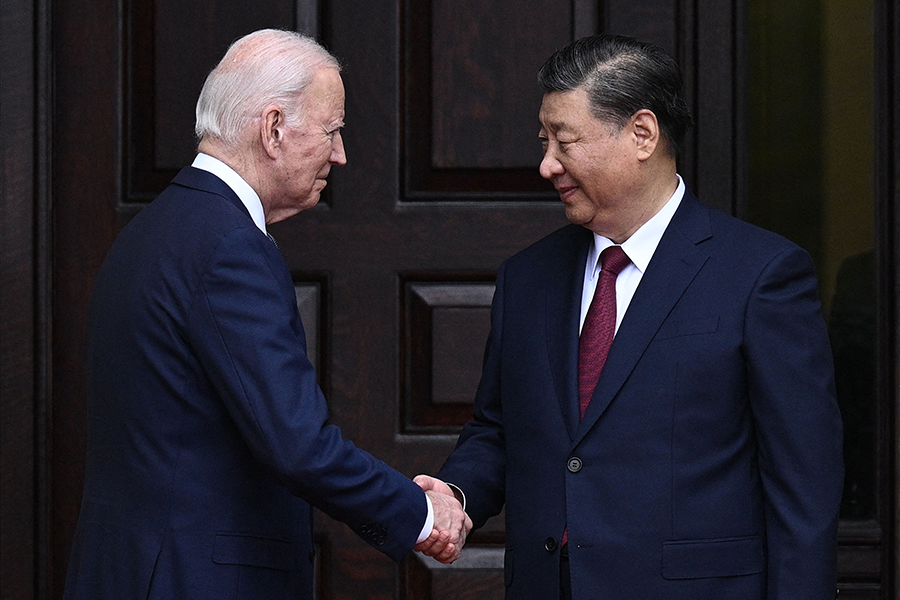"I greatly appreciate your very swift response, and your organization's work in general. It's a terrific source of authoritative information."
China, U.S. Hold Rare Arms Control Talks
December 2023
By Shizuka Kuramitsu
China and the United States held long-awaited talks on nuclear arms control on Nov. 6, the first such meeting in nearly in five years.
 Although the meeting in Washington produced no specific result and no specific date for follow-on talks was announced, U.S. officials said the discussion, which occurred amid rising nuclear and geopolitical tensions, was worthwhile simply because it took place.
Although the meeting in Washington produced no specific result and no specific date for follow-on talks was announced, U.S. officials said the discussion, which occurred amid rising nuclear and geopolitical tensions, was worthwhile simply because it took place.
In separate statements issued shortly after the meeting, the Chinese Foreign Ministry and the U.S. State Department described the discussion between Sun Xiaobo, Chinese director-general of arms control, and Mallory Stewart, U.S. assistant secretary of state for arms control, verification, and compliance, as candid, in-depth, and constructive.
The State Department said the issues under discussion “related to arms control and nonproliferation as part of ongoing efforts to maintain open lines of communication and responsibly manage the [bilateral] relationship.”
The United States, it said, “emphasized the importance of increased [Chinese] nuclear transparency and substantive engagement on practical measures to manage and reduce strategic risks across multiple domains, including nuclear and outer space,” and “the need to promote stability, help avert an unconstrained arms race, and manage competition so that it does not veer into conflict.”
The Chinese Foreign Ministry said the officials discussed the nuclear Nonproliferation Treaty, cooperation among the five nuclear-weapon states, nuclear security, nonproliferation and export control, compliance with the Biological Weapons Convention and the Chemical Weapons Convention, and outer space security and regular arms control.
According to Reuters, a senior U.S. official said on Nov. 7, “I wouldn't say we learned anything new from them or that they delved into a great amount of detail in terms of their own nuclear force, their buildup and whether or not their policy or doctrine could be shifting over time.”
The meeting occurred as Beijing and Washington sought to reengage after a prolonged estrangement and to find a way to manage their way forward as major competitors in an unstable world. The last bilateral meeting on arms control issues took place in 2018 in Beijing when Chinese and U.S. officials “exchanged views” on their respective nuclear policies and on mutual cooperation on nonproliferation, among other topics, according to the Chinese Foreign Ministry.
Among Washington’s major current concerns is Beijing’s nuclear weapons buildup and its refusal to allow more transparency into the country’s nuclear program.
In its latest report on China’s military power, the U.S. Defense Department estimated that China will possess in excess of 1,000 nuclear warheads by 2030 and will accelerate development of its intercontinental-range ballistic missiles. (See ACT, November 2023.)
“Compared to the PLA’s [People’s Liberation Army] nuclear modernization efforts a decade ago, current efforts dwarf previous attempts in both scale and complexity,” the report said. Regardless, China’s arsenal is dwarfed by those of Russia, which has 4,500 warheads, and the United States, which has roughly 3,800 warheads.
Biden has long called for China to join in arms control talks. The United States is ready to “engage China without preconditions, helping ensure that competition is managed and that competition does not veer into conflict,” National Security Advisor Jake Sullivan told the Arms Control Association annual forum on June 2.
“It’s our hope that…Beijing will be willing to include substantive engagement on strategic nuclear issues, which
would benefit the security of both of our countries and the security of the entire world,” Sullivan said.
During the Stewart-Sun meeting, the U.S. delegation “highlighted the need to promote stability, help avert an unconstrained arms race, and manage competition so that it does not veer into conflict,” the State Department statement said. Beijing, on the other hand, “emphasized that China and the United States should carry out dialogue and cooperation on the basis of mutual respect,” according to the Chinese Foreign Ministry.
China also “stressed that the two sides should adhere to the vision of common, comprehensive, cooperative and sustainable security [in order to] realize lasting peace and universal security in the world.”
The meeting between Stewart and Sun preceded the Nov. 15 meeting in San Francisco between Chinese President Xi Jinping and U.S. President Joe Biden and followed other recent high-level bilateral engagements, including between the U.S. secretary of state and the U.S. national security advisor with their Chinese counterparts.
According to a readout by the White House on the Xi-Biden talks, the leaders agreed that their teams will follow-up their discussions in San Francisco with “continued high-level diplomacy and interactions, including visits in both directions and ongoing working-level consultations in key areas, including on…arms control and nonproliferation.”
The State Department reported that the two leaders agreed to resume military-to-military communications and to continue their bilateral engagements “in key areas, including on commercial, economic, financial, Asia-Pacific, arms control and nonproliferation, maritime, export control enforcement, policy-planning, agriculture, and disability issues.”
In 2014, Xi told U.S. President Barack Obama that “the Pacific Ocean is broad enough to accommodate the development of both China and the United States and our two countries to work together to contribute to security in Asia.” When he met Biden, Xi told him that “planet Earth is big enough for the two countries to succeed.”
